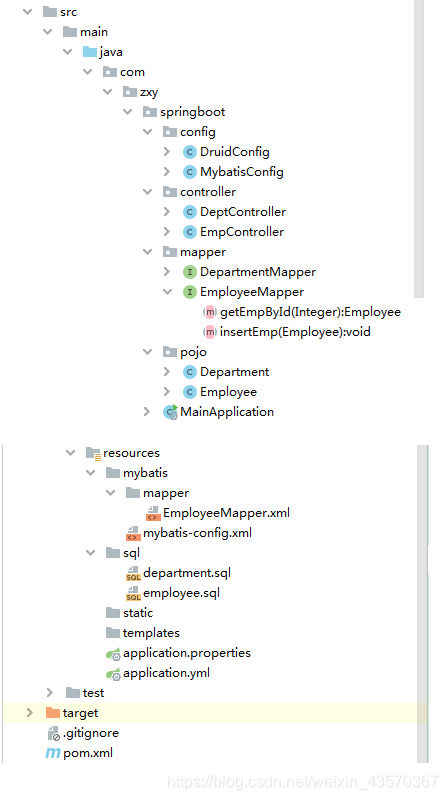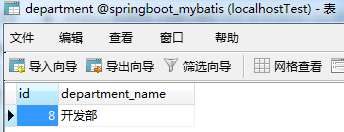写在前面:最近利用晚上的时间在网上看视频学习Spring Boot,这博客是对学习的一点点总结及记录,技术是开源的、知识是共享的。
如果你对Spring Boot 感兴趣,可以关注我的动态,我们一起学习。用知识改变命运,让家人过上更好的生活。
文章目录
源码地址: https://github.com/zhangxycg/springboot-mybatis
一、搭建开发环境
工程的目录结构如下图所示:

1. 创建数据库表
注:我在做的时候是用配置文件的形式自动创建的
department 表
CREATE TABLE `department` (
`id` int(11) NOT NULL AUTO_INCREMENT,
`department_name` varchar(255) CHARACTER SET utf8 COLLATE utf8_general_ci DEFAULT NULL,
PRIMARY KEY (`id`)
) ENGINE=InnoDB AUTO_INCREMENT=9 DEFAULT CHARSET=utf8;
employee 表
CREATE TABLE `employee` (
`id` int(11) NOT NULL AUTO_INCREMENT,
`lastName` varchar(255) DEFAULT NULL,
`email` varchar(255) DEFAULT NULL,
`gender` int(2) DEFAULT NULL,
`d_id` int(11) DEFAULT NULL,
PRIMARY KEY (`id`)
) ENGINE=InnoDB AUTO_INCREMENT=3 DEFAULT CHARSET=utf8;
2. 导入需要的依赖
pom.xml
<!-- Spingboot相关jar包版本 -->
<parent>
<groupId>org.springframework.boot</groupId>
<artifactId>spring-boot-starter-parent</artifactId>
<version>2.2.2.RELEASE</version>
<relativePath/> <!-- lookup parent from repository -->
</parent>
<dependencies>
<!-- springboot与JDBC整合包 -->
<dependency>
<groupId>org.springframework.boot</groupId>
<artifactId>spring-boot-starter-data-jdbc</artifactId>
</dependency>
<!-- 标识web应用 -->
<dependency>
<groupId>org.springframework.boot</groupId>
<artifactId>spring-boot-starter-web</artifactId>
</dependency>
<!--springboot与mybatis的整合包-->
<dependency>
<groupId>org.mybatis.spring.boot</groupId>
<artifactId>mybatis-spring-boot-starter</artifactId>
<version>2.1.1</version>
</dependency>
<!-- mysql 驱动包 -->
<dependency>
<groupId>mysql</groupId>
<artifactId>mysql-connector-java</artifactId>
<scope>runtime</scope>
</dependency>
<!-- 引入druid -->
<dependency>
<groupId>com.alibaba</groupId>
<artifactId>druid</artifactId>
<version>1.1.8</version>
</dependency>
<dependency>
<groupId>org.springframework.boot</groupId>
<artifactId>spring-boot-starter-test</artifactId>
<scope>test</scope>
<exclusions>
<exclusion>
<groupId>org.junit.vintage</groupId>
<artifactId>junit-vintage-engine</artifactId>
</exclusion>
</exclusions>
</dependency>
</dependencies>
3. 编写数据源的相关配置
application.yml
spring:
datasource:
# 数据源基本配置
username: root
password: root
driver-class-name: com.mysql.cj.jdbc.Driver
url: jdbc:mysql://localhost:3306/springboot_mybatis?serverTimezone=GMT%2B8
type: com.alibaba.druid.pool.DruidDataSource
# 数据源其他配置
initialSize: 5
minIdle: 5
maxActive: 20
maxWait: 60000
timeBetweenEvictionRunsMillis: 60000
minEvictableIdleTimeMillis: 300000
validationQuery: SELECT 1 FROM DUAL
testWhileIdle: true
testOnBorrow: false
testOnReturn: false
poolPreparedStatements: true
# 配置监控统计拦截的filters,去掉后监控界面sql无法统计,'wall'用于防火墙
filters: stat,wall,slf4j
maxPoolPreparedStatementPerConnectionSize: 20
useGlobalDataSourceStat: true
connectionProperties: druid.stat.mergeSql=true;druid.stat.slowSqlMillis=500
# initialization-mode: always
# schema:
# - classpath:sql/department.sql
# - classpath:sql/employee.sql
编写一个配置类,将数据源引入过来
@Configuration
public class DruidConfig {
@ConfigurationProperties(prefix = "spring.datasource")
@Bean
public DataSource druid(){
return new DruidDataSource();
}
// 配置Druid的监控
// 配置一个管理后台的Servlet
@Bean
public ServletRegistrationBean statViewServlet(){
ServletRegistrationBean bean = new ServletRegistrationBean(new StatViewServlet(), "/druid/*");
Map<String,String> initParams = new HashMap<>();
initParams.put("loginUsername","admin");
initParams.put("loginPassword","123456");
initParams.put("allow","");//默认就是允许所有访问
bean.setInitParameters(initParams);
return bean;
}
// 配置一个web监控的filter
@Bean
public FilterRegistrationBean webStatFilter(){
FilterRegistrationBean bean = new FilterRegistrationBean();
bean.setFilter(new WebStatFilter());
Map<String,String> initParams = new HashMap<>();
initParams.put("exclusions","*.js,*.css,/druid/*");
bean.setInitParameters(initParams);
bean.setUrlPatterns(Arrays.asList("/*"));
return bean;
}
}
二、利用注解的形式整合
1. 编写实体类
Employee
public class Employee {
private Integer id; // 员工id
private String lastName; // 员工姓名
private Integer gender; // 员工性别
private String email; // 员工邮箱
private Integer dId; // 部门id
public Integer getId() {
return id;
}
public void setId(Integer id) {
this.id = id;
}
public String getLastName() {
return lastName;
}
public void setLastName(String lastName) {
this.lastName = lastName;
}
public Integer getGender() {
return gender;
}
public void setGender(Integer gender) {
this.gender = gender;
}
public String getEmail() {
return email;
}
public void setEmail(String email) {
this.email = email;
}
public Integer getdId() {
return dId;
}
public void setdId(Integer dId) {
this.dId = dId;
}
}
Department
public class Department {
private Integer id; // 部门id
private String departmentName; // 部门名称
public Integer getId() {
return id;
}
public void setId(Integer id) {
this.id = id;
}
public String getDepartmentName() {
return departmentName;
}
public void setDepartmentName(String departmentName) {
this.departmentName = departmentName;
}
}
2. 编写 Mapper接口层
DepartmentMapper
@Mapper // 指定这是一个操作数据库的mapper,将接口扫描到容器中
public interface DepartmentMapper {
/**
* 查询
*
* @param id
* @return
*/
@Select("select * from department where id=#{id}")
public Department getDeptById(Integer id);
/**
* 删除
*
* @param id
* @return
*/
@Delete("delete from department where id=#{id}")
public int deleteDeptById(Integer id);
/**
* 新增
*
* @param department
* @return
*/
@Options(useGeneratedKeys = true,keyProperty = "id")
@Insert("Insert into department(department_name) values(#{departmentName})")
public int insertDept(Department department);
/**
* 更新
*
* @param department
* @return
*/
@Update("update department set department_name=#{departmentName} where id=#{id}")
public int updateDept(Department department);
}
3. 编写 Controller 层
DeptController
@RestController
public class DeptController {
@Autowired
DepartmentMapper departmentMapper;
/**
* 根据id进行查询
*
* @param id
* @return
*/
@GetMapping("/dept/{id}")
public Department getDepartment(@PathVariable("id") Integer id) {
return departmentMapper.getDeptById(id);
}
/**
* 新增部门信息
*
* @param department
* @return
*/
@GetMapping("/dept")
public Department insertDept(Department department) {
departmentMapper.insertDept(department);
return department;
}
}
在不写配置文件的情况 自定义mybatis的配置规则,开启驼峰命名法
@org.springframework.context.annotation.Configuration
public class MybatisConfig {
@Bean
public ConfigurationCustomizer configurationCustomizer() {
return new ConfigurationCustomizer() {
@Override
public void customize(Configuration configuration) {
configuration.setMapUnderscoreToCamelCase(true);
}
};
}
}
4. 测试
插入一条数据

查询刚才插入的数据

去数据库表表里面查询,数据插入进去了

二、利用配置文件的形式整合
1. 编写 Mapper 接口层
EmployeeMapper
@Mapper
public interface EmployeeMapper {
/**
* 根据id查询员工信息
*
* @param id
* @return
*/
public Employee getEmpById(Integer id);
/**
* 新增员工信息
*
* @param employee
*/
public void insertEmp(Employee employee);
}
2. 编写全局配置文件
mybatis-config.xml
<?xml version="1.0" encoding="UTF-8" ?>
<!DOCTYPE configuration
PUBLIC "-//mybatis.org//DTD Config 3.0//EN"
"http://mybatis.org/dtd/mybatis-3-config.dtd">
<configuration>
<!-- 开启驼峰命名法 -->
<settings>
<setting name="mapUnderscoreToCamelCase" value="true"/>
</settings>
</configuration>
3. 编写 Sql 映射文件
<?xml version="1.0" encoding="UTF-8" ?>
<!DOCTYPE mapper
PUBLIC "-//mybatis.org//DTD Mapper 3.0//EN"
"http://mybatis.org/dtd/mybatis-3-mapper.dtd">
<mapper namespace="com.zxy.springboot.mapper.EmployeeMapper">
<!-- 根据id查询员工信息 -->
<select id="getEmpById" resultType="com.zxy.springboot.pojo.Employee">
SELECT * FROM employee WHERE id=#{id}
</select>
<!-- 新增员工信息 -->
<insert id="insertEmp">
INSERT INTO employee(lastName,email,gender,d_id) VALUES (#{lastName},#{email},#{gender},#{dId})
</insert>
</mapper>
4. 在 application.yml 中进行相关配置
mybatis:
# 全局配置文件的位置
config-location: classpath:mybatis/mybatis-config.xml
# mapper 映射文件的位置
mapper-locations: classpath:mybatis/mapper/*.xml
5. 编写 Controller 层
Controller
@RestController
public class EmpController {
@Autowired
EmployeeMapper employeeMapper;
/**
* 根据id查询员工信息
*
* @param id
* @return
*/
@GetMapping("/emp/{id}")
public Employee getEmp(@PathVariable("id") Integer id) {
return employeeMapper.getEmpById(id);
}
/**
* 新增员工信息
*
* @param employee
* @return
*/
@GetMapping("/emp")
public Employee insertEmp(Employee employee) {
employeeMapper.insertEmp(employee);
return employee;
}
}
6. 测试

